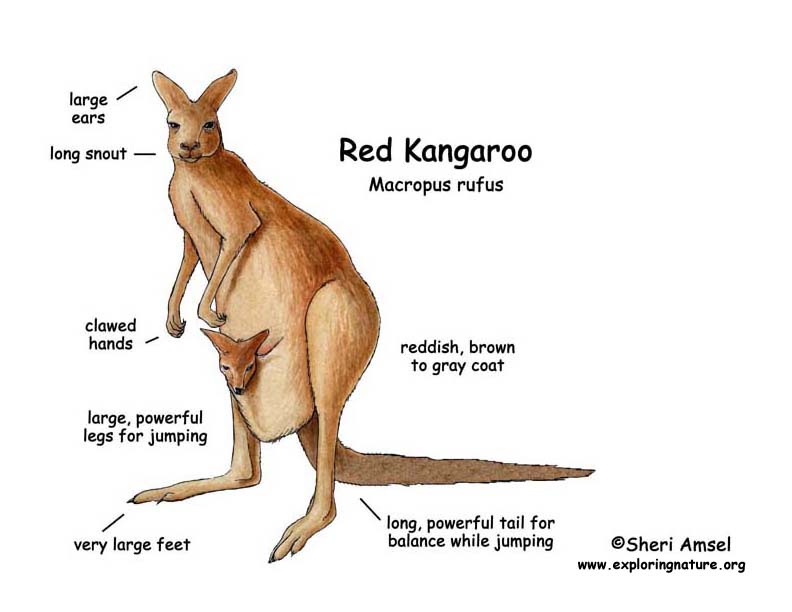

Kangaroos are found in Australia and Tasmania, and some nearby islands.
They live in forests, dry scrublands and open grasslands.
There are three kinds of kangaroos: red, eastern gray and western gray. Red and gray kangaroos can grow to 5-6 feet tall. They can weigh up to 200 pounds, though most weigh around 100 pounds. Female kangaroos are smaller. As their names suggest, they have reddish, brown to gray coats of coarse, wooly hair.
They live in groups called "mobs" that are ruled by the biggest male. Kangaroos can travel at speeds up to 30 mph and can jump 30 feet. They use their tails as a counter balance.
Kangaroos eat plants (herbivores). They mostly eat grass and can survive a long time without water.
Predators are dingo and man.
Female kangaroos are only pregnant for about 1 month (gestation) and give birth to one tiny baby or “joey.” Kangaroos are marsupials so the females carry the “joeys,” in a pouch on the front of their bellies. Newborns weigh less than 1/10 of an ounce at birth and have to crawl up into their mother’s pouch to nurse and grow. They will stay in their mother’s pouch for 8 months to a year.
Kangaroos live for 6 - 8 years in the wild. All kangaroos is listed as Lower Risk - least concern.
Red Kangaroo -
Kingdom: Animalia
Phylum: Chordata
Subphylum: Vertebrata
Class: Mammalia
Order: Diprotodontia
Suborder: Macropodiformes
Family: Macropodidae
Subfamily: Macropodinae
Genus: Macropus
Species: Macropus rufus
Eastern Gray -
Kingdom: Animalia
Phylum: Chordata
Subphylum: Vertebrata
Class: Mammalia
Order: Diprotodontia
Suborder: Macropodiformes
Family: Macropodidae
Subfamily: Macropodinae
Genus: Macropus
Species: Macropus giganteus
Western Gray -
Kingdom: Animalia
Phylum: Chordata
Subphylum: Vertebrata
Class: Mammalia
Order: Diprotodontia
Suborder: Macropodiformes
Family: Macropodidae
Subfamily: Macropodinae
Genus: Macropus
Species: Macropus fuliginosus
When you research information you must cite the reference. Citing for websites is different from citing from books, magazines and periodicals. The style of citing shown here is from the MLA Style Citations (Modern Language Association).
When citing a WEBSITE the general format is as follows.
Author Last Name, First Name(s). "Title: Subtitle of Part of Web Page, if appropriate." Title: Subtitle: Section of Page if appropriate. Sponsoring/Publishing Agency, If Given. Additional significant descriptive information. Date of Electronic Publication or other Date, such as Last Updated. Day Month Year of access < URL >.
Amsel, Sheri. "Kangaroo" Exploring Nature Educational Resource ©2005-2024. December 13, 2024
< http://www.exploringnature.org/db/view/342 >

